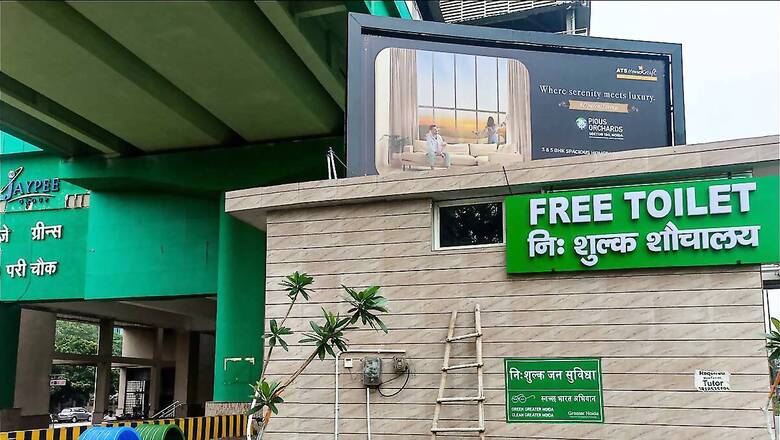
views
Monsoons are a gift from nature, a time when the heavens open up and bestow upon us the life-giving rainfall that our land so desperately needs. As the raindrops fall, they nourish our water bodies and breathe life into our agricultural activities. Yet, amidst this beautiful display of nature’s generosity, there are challenges that arise, particularly when it comes to maintaining clean and hygienic conditions in our toilets.
India, where the monsoon season can be particularly intense, these maintenance practices are not just about comfort and aesthetics, but also about preventing the spread of diseases. Waterborne diseases such as diarrhoea and cholera are much more common during the monsoon season, and often spread because of poor sanitation practices and toilet hygiene.
Consequently, a clean and hygienic toilet can play a crucial role in preventing these diseases. Proper maintenance also keeps toilets from getting waterlogged, from becoming smelly and dirty (especially during the monsoons when things take forever to dry up), and from becoming ecological hazards (by preventing leaks of toilet waste and sewage water into surrounding lands and water).
Keeping Toilets Clean and Well Maintained: The Basics
There are a number of technological solutions out there: e-toilets that clean themselves after every use, sensor equipped toilets that flush themselves rather than wait for the users to do it, and so on. A simple Google search reveals a plethora of both weird and delightful innovations from across the globe, where innovators are working on how to make toilet cleanliness and maintenance “automatic”.
However, these technological marvels aside, there are a number of basic things we can do to ensure that our toilets are always up to the mark – be they our own toilets, or those belonging to the community.
Ensure Adequate Drainage
One of the primary concerns during the monsoon season is waterlogging. To prevent water from accumulating in and around toilets, it is important to ensure proper drainage systems. Regularly inspect the drainage pipes and gutters, clearing any blockages that may impede the flow of water. If necessary, consider installing additional drains or improving the existing ones to handle the increased water flow during heavy rainfall.
Check and Repair Leaks
Leaks can greatly turn up the volume on the problems caused by heavy rains during the monsoon season. Thoroughly inspect the toilets for any signs of leaks, such as dripping faucets or water seepage. Promptly repair any leaks to prevent water wastage and potential damage to the toilet structure. Regularly check the water supply lines, flush tanks, and pipes for leaks or cracks. It is advisable to consult a professional plumber if you encounter any significant plumbing issues.
Maintain Proper Ventilation
Proper ventilation is essential to prevent the accumulation of moisture and foul odours in toilets, particularly during the monsoon season. Ensure that the ventilation systems, such as exhaust fans or windows, are functioning effectively. Clean or replace air filters regularly to ensure good air quality and prevent the growth of mould or mildew. Adequate ventilation also helps in reducing the humidity levels inside the toilets, creating a more comfortable environment for users.
Ensure Adequate Lighting
Well-lit toilets deter insects and rodents from infesting the facilities. By maintaining proper lighting, the risk of infestation is minimised, ensuring a clean and safe environment for toilet users.
Active and Passive Pest Control
Active pest control involves using insect repellents and sprays for mosquitoes and flies, and all those gels, dots, lines and sprays used for cockroaches and other creepy crawlies. Passive pest control involves lighting and ventilation, and sealing all the cracks along the drains and the walls themselves. In the monsoon in particular, the windows need mesh coverings too, to keep out flying insects.
Clean and Disinfect Regularly
To keep toilets free from germs and maintain hygiene, it is essential to clean and disinfect them regularly. During the monsoon season, it is recommended to wipe down and disinfect toilets at least twice a day to prevent the growth of bacteria and viruses.
Depending on how frequently the toilet is used, it is important to establish a cleaning schedule for the toilet bowl itself. The cleaning regime itself is straightforward: start by flushing the toilet and then apply a good quality toilet cleaner, such as Harpic, to the bowl and under the rim. Allow it to sit for a few minutes before scrubbing the inside with a toilet brush. Pay special attention to the areas around the rim and the hinges. After scrubbing, flush the toilet again to rinse off the cleaner.
Remember to clean the seat, lid, and outer surfaces of the toilet as well, using a disinfectant cleaner. Regular cleaning and disinfection will help reduce the risk of infections and keep your toilet germ-free. Use a floor cleaner to cleanse the floors, and dry off any damp patches with a mop.
Common mistakes we’re all making in our toilet cleaning regimen
If the previous sentence made you roll your eyes, think again. There are a number of things that we’re doing wrong when it comes to our toilet hygiene. Why? Because no one taught us how. At home, the work is done by our maids, or our mothers. Who taught them? Probably no one – same as us.
So, without further ado, here are some of the things that many of us get wrong:
Not wearing gloves: Many people forget to wear gloves while cleaning the toilet, exposing themselves to harmful bacteria and germs. Always wear gloves when cleaning the toilet to protect your hands and prevent the spread of bacteria.
Using harsh chemicals: Harsh chemicals like acid and other non-standard cleaning products may seem like they can clean your toilet, but they can actually damage the surface (making it porous, and therefore harder to clean next time) and even harm your health. Instead, use proven toilet cleaning products like Harpic, which are specially formulated for use in home toilets.
Neglecting the toilet brush: The toilet brush is an essential tool for cleaning the toilet, but many people don’t clean it after use, leaving it filled with germs and bacteria. After cleaning the toilet, rinse the brush thoroughly and store it in a clean, dry place.
Forgetting to clean the base and surrounding area: Many people focus only on cleaning the inside of the toilet bowl, but neglect the base and surrounding area. Don’t forget to clean these areas too, as they can harbour bacteria and germs.
Not letting the cleaner sit for long enough: If you’re using a cleaning solution, make sure to let it sit for the recommended amount of time before scrubbing. This allows the solution to work effectively and clean the toilet thoroughly.
Flushing the toilet with the lid open: Flushing the toilet with the lid open can cause a toilet plume. This creates a spray of germs and bacteria to spread throughout the bathroom, and on your clothing (and your phone, if you took it inside with you). Always close the lid before flushing to prevent the spread of germs.
Using the same cleaning cloth for multiple surfaces: Using the same cloth to clean the toilet and other surfaces in the bathroom can spread germs and bacteria. Use separate cleaning cloths for each surface, and wash them regularly.
If at least one of the items on this list made you squirm in embarrassment, we feel you. There is a crucial gap in this area of knowledge, and it is culturally driven. In India, sanitation work is considered ‘beneath us’, and so, we aren’t taught how to maintain our own toilets, in our own homes. Is it any surprise then, that our common toilets look the way they do?
This is exactly why Harpic, a leader in the lavatory care segment, has been toiling away all these years, to build a compendium of knowledge around this neglected area of home care. Think about it: the last time you cleaned your toilet bowl, you positioned the Harpic nozzle exactly as you’re supposed to, under the rim, and moved it around so the liquid covered every inch of the surface. You then waited 20 minutes, then went to work scrubbing it out, and then flushed it.
Question: who taught you that? Most likely, you didn’t have to think about it, because you’d seen Harpic’s ads so often, and you knew how to do this because the information had been repeated over and over and over, till it was second nature to you. That’s the essence of good communication. Over the years, Harpic has built strong communication strategies around the need for good toilet hygiene habits in particular, and sanitation overall, through thought provoking campaigns and outreach programs.
Of course, Harpic doesn’t just talk to adults. They partnered with Sesame Workshop India, an educational non-profit working for the early developmental needs of young children, to promote positive sanitation, hygiene knowledge and behaviours among children and families through schools and communities, engaging with 17.5 million children across India. This, in addition to the messaging they already aimed at adults.
Harpic, in addition to creating programming aimed at young children, also pioneered a programme to raise awareness and reinforce healthy toilet and bathroom habits among young children, developing and recognising them as “Swachhta Champions”. These initiatives are a part of the larger umbrella campaign, Harpic Mission Swachhta and Paani, with News18.
Mission Swachhta aur Paani, pioneered by Harpic and News18, is a movement that upholds the cause of inclusive sanitation where everyone has access to clean toilets. It advocates equality for all genders, abilities, castes and classes and strongly believes that clean toilets are a shared responsibility. Clean and safe toilets for all means that our communities are healthier, our children spend more days in school and less days out sick, girls don’t drop out of school, our workplaces are more diverse places, and that our cities and towns are cleaner, safer, and more welcoming.
Mission Swachhta aur Paani is creating repositories of information on every conceivable topic around toilet use, and how it impacts us individually, as well as the larger society. Of course, it also contains a number of resources that help you educate yourself on how to maintain a healthy and safe toilet environment at home.
Proper maintenance of toilets during the monsoon season is crucial for creating a healthy and hygienic environment for users. A healthy environment benefits everyone and contributes to the overall well-being of individuals and communities.
So as the rains nourish the land, let our actions nurture the health of our people. With kindness and determination, we can turn this season of challenges into one of solutions. Working together, we can ensure all Indians enjoy the monsoon rains safely.
Join us here, to learn how you can do this at your own home, and how you can take on a larger role in moving our communities towards a Swachh and Swasth Bharat.



















Comments
0 comment